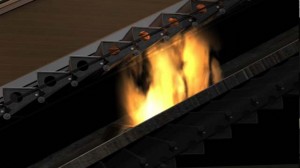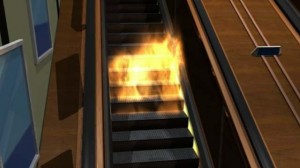Trial Graphics: London Underground: Fire Dynamics
TMBA provided the accident recreations of the London Underground for the series "Extreme Evidence" (Court TV). These accident recreations are based on the investigation report from the London Fire Brigade.
The Fire
The fire started on an escalator between the Piccadilly Line platforms and the ticket hall at King's Cross St. Pancras tube station. The evidence of many eyewitnesses indicated that at the early stages, the fire in the escalator was obviously of manageable size: officers from the Fire Brigade and British Transport Police gave evidence that the fire appeared no larger than a large cardboard box burning.
Those present were all taken by surprise when it suddenly changed into something that threw a sustained jet of flame into the ticket hall.
What seems clear is that in the early stages of the fire, the flames visible to anyone not standing on the burning escalator were a small part of the full story. The majority of the flames were lying down in the escalator trench; only a few protruded above the balustrade and were visible to observers. The lack of visible flames lulled the emergency services into a false sense of security. When the treads of the escalator flashed over, the size of the fire increased dramatically and set most of the ticket
hall alight.
Trench Effect
The trench effect is a combination of circumstances that can cause a fire to climb rapidly up an inclined surface. It depends on two well-understood but separate ideas: the Coandă effect from fluid dynamics and the flashover concept from fire dynamics.
The Coandă effect is the tendency of a fast-moving stream of air to deflect towards nearby surfaces. The fast-moving stream tends to experience a decrease in static pressure, which creates a pressure difference between those areas far from the wall and the wall itself. This bends the fast-moving stream towards the surface and tends to keep it attached to that surface. Flashover is a sudden widespread spreading of fire, which occurs when the majority of surfaces in a space are heated to the point at which they give off flammable gases hot enough to ignite themselves.
Flashover is a sudden widespread spreading of fire, which occurs when the majority of surfaces in a space are heated to the point at which they give off flammable gases hot enough to ignite themselves.
The trench effect occurs when a fire burns next to a steeply-inclined surface. The flames lie down along the surface, in accordance with the Coandă effect. The flames heat the material farther up: these emit gases, reach their auto-ignition temperature and then start burning, in accordance with flashover theory. The flames from these areas blow a jet of flame up to the end of the inclined surface. This jet is sustained until the fuel is exhausted.
Next Page: Toxic Tort: Environmental Contamination
